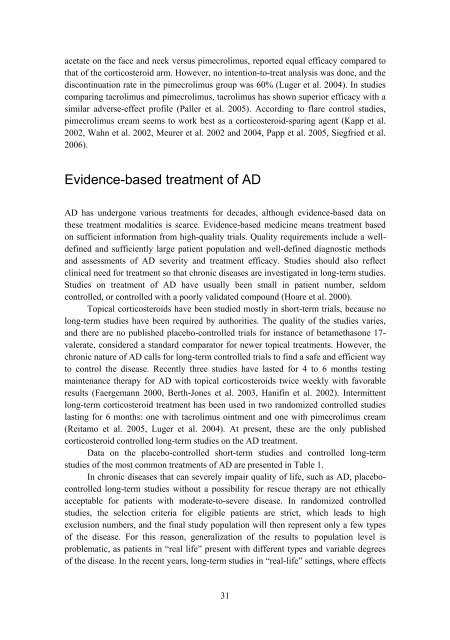Topical tacrolimus in atopic dermatitis: Effects of ... - Helda - Helsinki.fi
Topical tacrolimus in atopic dermatitis: Effects of ... - Helda - Helsinki.fi
Topical tacrolimus in atopic dermatitis: Effects of ... - Helda - Helsinki.fi
Create successful ePaper yourself
Turn your PDF publications into a flip-book with our unique Google optimized e-Paper software.
acetate on the face and neck versus pimecrolimus, reported equal ef<strong>fi</strong>cacy compared to<br />
that <strong>of</strong> the corticosteroid arm. However, no <strong>in</strong>tention-to-treat analysis was done, and the<br />
discont<strong>in</strong>uation rate <strong>in</strong> the pimecrolimus group was 60% (Luger et al. 2004). In studies<br />
compar<strong>in</strong>g <strong>tacrolimus</strong> and pimecrolimus, <strong>tacrolimus</strong> has shown superior ef<strong>fi</strong>cacy with a<br />
similar adverse-effect pr<strong>of</strong>ile (Paller et al. 2005). Accord<strong>in</strong>g to flare control studies,<br />
pimecrolimus cream seems to work best as a corticosteroid-spar<strong>in</strong>g agent (Kapp et al.<br />
2002, Wahn et al. 2002, Meurer et al. 2002 and 2004, Papp et al. 2005, Siegfried et al.<br />
2006).<br />
Evidence-based treatment <strong>of</strong> AD<br />
AD has undergone various treatments for decades, although evidence-based data on<br />
these treatment modalities is scarce. Evidence-based medic<strong>in</strong>e means treatment based<br />
on suf<strong>fi</strong>cient <strong>in</strong>formation from high-quality trials. Quality requirements <strong>in</strong>clude a welldef<strong>in</strong>ed<br />
and suf<strong>fi</strong>ciently large patient population and well-def<strong>in</strong>ed diagnostic methods<br />
and assessments <strong>of</strong> AD severity and treatment ef<strong>fi</strong>cacy. Studies should also reflect<br />
cl<strong>in</strong>ical need for treatment so that chronic diseases are <strong>in</strong>vestigated <strong>in</strong> long-term studies.<br />
Studies on treatment <strong>of</strong> AD have usually been small <strong>in</strong> patient number, seldom<br />
controlled, or controlled with a poorly validated compound (Hoare et al. 2000).<br />
<strong>Topical</strong> corticosteroids have been studied mostly <strong>in</strong> short-term trials, because no<br />
long-term studies have been required by authorities. The quality <strong>of</strong> the studies varies,<br />
and there are no published placebo-controlled trials for <strong>in</strong>stance <strong>of</strong> betamethasone 17valerate,<br />
considered a standard comparator for newer topical treatments. However, the<br />
chronic nature <strong>of</strong> AD calls for long-term controlled trials to f<strong>in</strong>d a safe and ef<strong>fi</strong>cient way<br />
to control the disease. Recently three studies have lasted for 4 to 6 months test<strong>in</strong>g<br />
ma<strong>in</strong>tenance therapy for AD with topical corticosteroids twice weekly with favorable<br />
results (Faergemann 2000, Berth-Jones et al. 2003, Hanif<strong>in</strong> et al. 2002). Intermittent<br />
long-term corticosteroid treatment has been used <strong>in</strong> two randomized controlled studies<br />
last<strong>in</strong>g for 6 months: one with <strong>tacrolimus</strong> o<strong>in</strong>tment and one with pimecrolimus cream<br />
(Reitamo et al. 2005, Luger et al. 2004). At present, these are the only published<br />
corticosteroid controlled long-term studies on the AD treatment.<br />
Data on the placebo-controlled short-term studies and controlled long-term<br />
studies <strong>of</strong> the most common treatments <strong>of</strong> AD are presented <strong>in</strong> Table 1.<br />
In chronic diseases that can severely impair quality <strong>of</strong> life, such as AD, placebocontrolled<br />
long-term studies without a possibility for rescue therapy are not ethically<br />
acceptable for patients with moderate-to-severe disease. In randomized controlled<br />
studies, the selection criteria for eligible patients are strict, which leads to high<br />
exclusion numbers, and the f<strong>in</strong>al study population will then represent only a few types<br />
<strong>of</strong> the disease. For this reason, generalization <strong>of</strong> the results to population level is<br />
problematic, as patients <strong>in</strong> “real life” present with different types and variable degrees<br />
<strong>of</strong> the disease. In the recent years, long-term studies <strong>in</strong> “real-life” sett<strong>in</strong>gs, where effects<br />
31

















